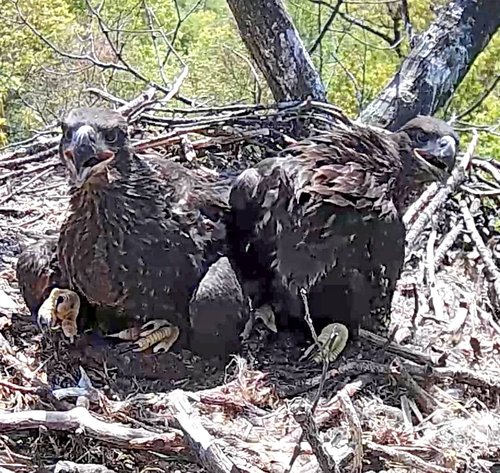Hanover Bald Eagle Blog # 18 - 2022
In partnership with Pennsylvania Game Commission and Comcast Business .
The first Hanover eaglet hatched 7 weeks ago. Now that the Hanover eaglets are approaching their final stage in the nest, they are demonstrating more curiosity-driven behaviors such as picking up sticks, challenging family members, observing the comings and goings of other creatures, inspecting newly-delivered prey items, and peering over the side with interest. The nest has become a learning hub — a school in the trees.

Eagles in this area first constructed this nest in 2004. Bald eagles are known for their allegiance to the nests they build, as long as their needs are met at that site. This pattern of return is called site fidelity. Females lead the search for the perfect home, but both sexes help construct the nest. Here are some of the factors a pair considers when choosing their site:
- Does it offer protection from predators?
- Does it offer a commanding view of the area for hunting and guarding purposes?
- Will the selected tree/cliff/ground be able to support a large nest?
- Can they fly in and out of the nest with ease?
- Is the site close to water?
- Is it sheltered from the elements?
Understandably, with all of these considerations, new parents can get it wrong. Therefore, young eagles (2-4 years old) sometimes create practice nests before they are ready to breed.
Bald eagles typically choose living trees with broken tops. They aim to build their nest in a notch that is sheltered from the elements and strong enough to support two rambunctious eaglets. Pairs construct and/or refurbish their nests 1-3 months prior to laying. Eagles are diligent architects, rearranging sticks several times over to ensure they land in the right spot.
Nesting materials vary by region — in the Pacific Northwest nests may contain kelp and driftwood while here at the Hanover nest we see the parents fly in with straw and corn husks. In Florida observers watched an eagle pair cushion their nest with fourteen inches of Spanish moss over the course of one month.
Nest sizes vary based on how long they’ve been used, but a typical bald eagle nest clocks out at 5 feet across and 3 feet deep. The largest bald eagle nest so far recorded was built in St. Petersburg, Florida. This whopper, which is listed as the largest known bird nest in the Guinness World Records, came in at 9.5 feet across, 20 feet deep, and weighed nearly 3 tons!
Watch this video for an audio and visual summary of bald eagle nest building.
This is a delightful time to watch the eaglets gain comfort with their surroundings. Their nest is no longer merely a soft bed to lie in — now, it’s a place for the eaglets to test their limits and prepare for their first flight into a new world.
Sources
Gerrard, Jon M. & Bortolotti, R. Gary. (1988). The Bald Eagle: Haunts and Habits of a Wilderness Monarch. Smithsonian Institution.

Raptor Ecology Specialist - Zoey Greenberg
RETURN TO HANOVER BALD EAGLE BLOGS
WATCH THE HANOVER BALD EAGLE LIVE CAMS
For over 20 years, HDOnTap has provided live streaming solutions to resorts, amusement parks, wildlife refuges and more. In addition to maintaining a network of over 400 live webcams, HDOnTap specializes in design and installation of remote, off-grid and otherwise challenging live streaming solutions. Contact press@hdontap.com for all media needs, including images and recordings.